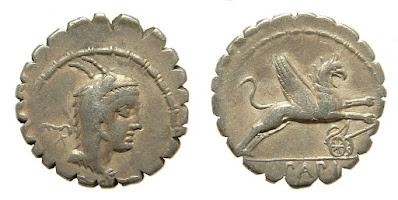This Roman Republican denarius, issued by Lucius Papius c. 79 BC (Crawford 384/1) is known for the use of a, huge series of control marks on both the obverse and reverse. When compiling his catalogue in the 1970s Crawford identified 211 pairs, each pairing of symbols has only one pair of dies, and of which this is pairing 119 (twin yoke on the obverse, behind the head of Juno Sospita, and a cart on the reverse, below the leaping griffin).
I had never really contemplated what the control marks were actually meant to be controlling, that was until I came across Harlan’s two books on the Roman Republican Moneyers. He suggests that it is to stop theft or work slacking by the mint workers producing the coins. As each pairing of marks were from single dies it, presumably each assigned to a single worker, would be easy to detect if, on a daily basis (or whatever frequency) a particular pairing was deficient in number produced compared with the other pairings.
Another feature of this series, in common with the products of some other moneyers, is the serrated edge to the coin. The serrated edge is individually chiseled onto each coin blank before the design is struck. The reason is unclear. Some say it is to demonstrate that the coin is silver through and through, not plate metal on a base metal core. Crawford doubts this as there are unserrated coins produced in the same period as serrated ones. Because of that Crawford suggests that the serrated flan is merely an artistic choice. To me that seems a little odd, and Harlan postulate that it is another method of deterring theft by the mint workers. The serrated edge is to make the coins look uncomfortable to swallow to then recover later after the natural course of events!
